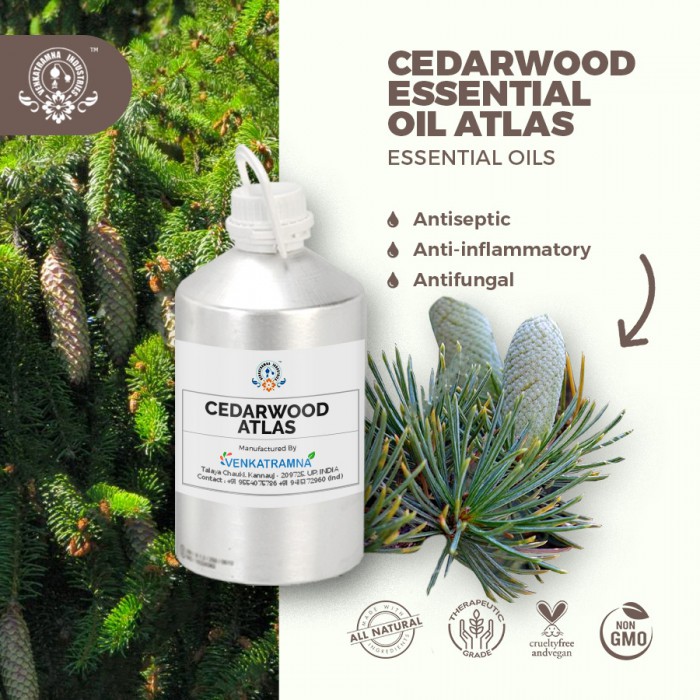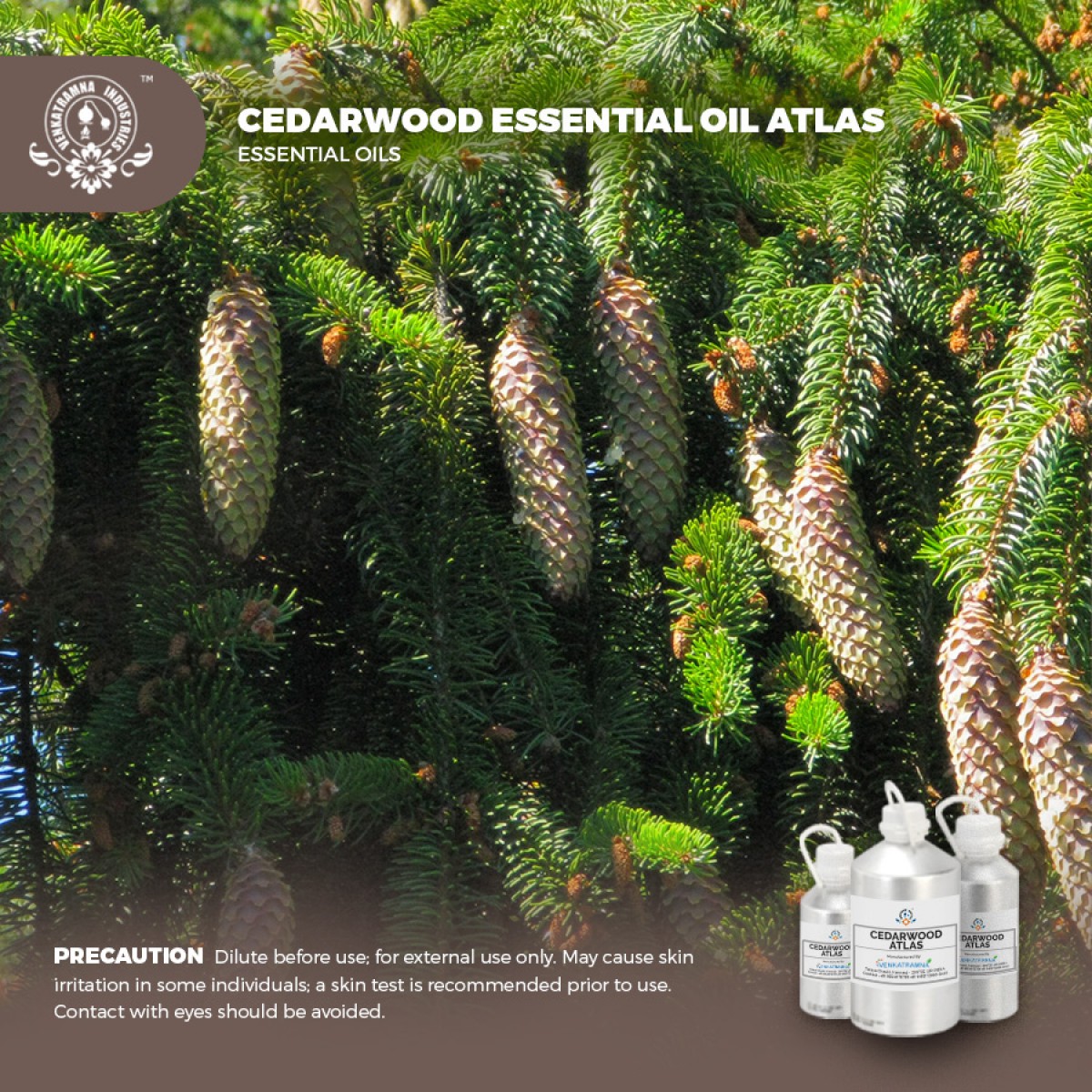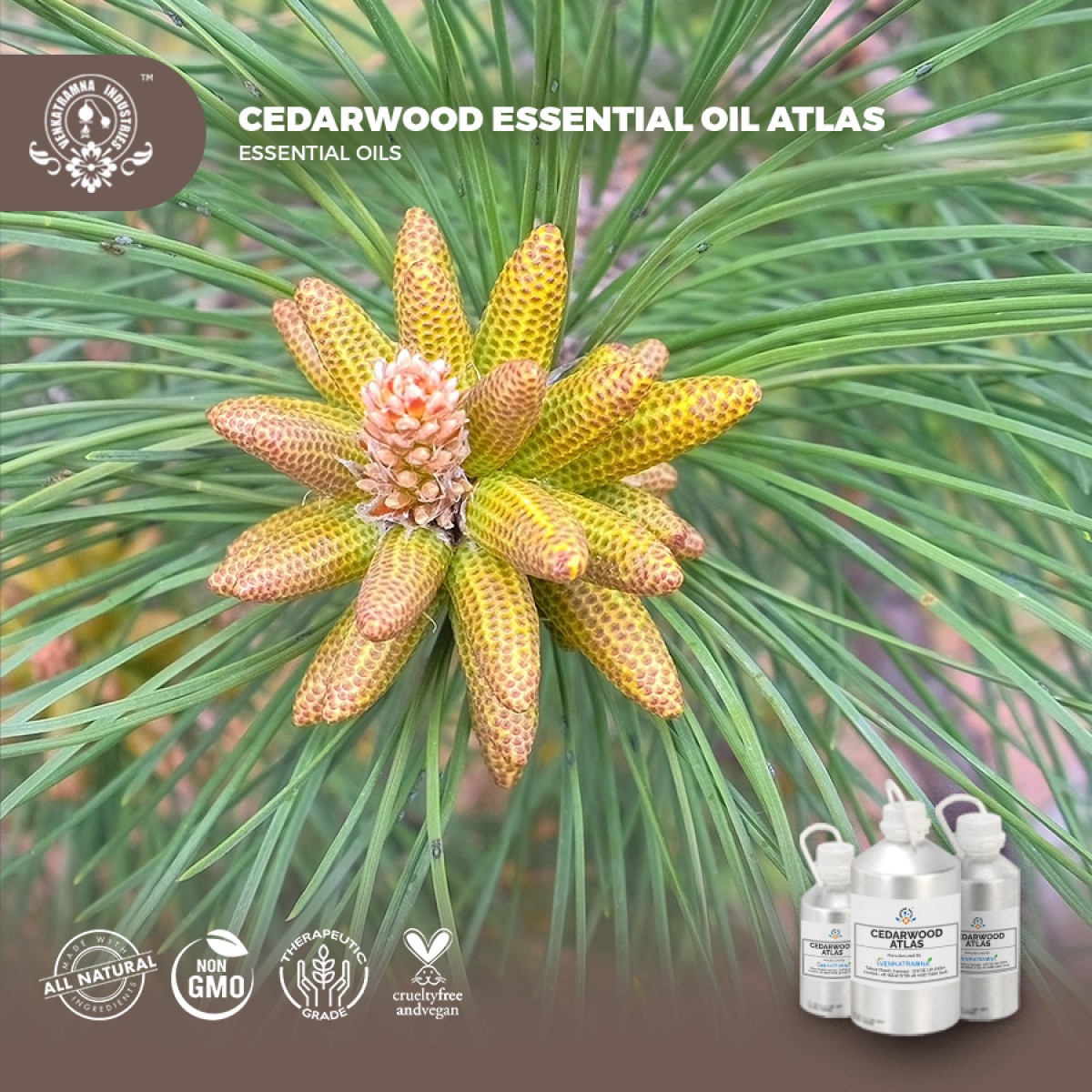Botanical Name: Cedrus atlantica Common name: Atlantic cedar, Blue atlas Cedar, Atlas Read More
|
Botanical Name: |
Cedrus atlantica |
|
Common name: |
Atlantic cedar, Blue atlas Cedar, Atlas Cedar |
|
Plant family: |
Pinaceae |
|
Genus: |
Cedrus |
|
Appearance/Color: |
A thin, golden
yellow to orange or brown liquid. |
|
Odor: |
A middle note of
strong aroma, cedarwood atlas oil has a woody, sweet, scent that is sharper
than Virginian cedarwood, and slightly reminiscent of mothballs. |
|
Blends With: |
Rosewood,
bergamot, cypress, cassia, jasmine, juniper, neroli, labdanum, frankincense,
clary sage, vetive, rosemary, ylang-ylang. |
|
Origin |
Morocco |
|
Source |
Wood |
|
Method of
Extraction |
Steam Distillation |
Cedar trees in general have a
long history of use for furniture and buildings as well as in various herbal remedies
and aromatherapy preparations. According to the Old Testament, King Hiram of
Tyre sent cedar wood from Lebanon to King Solomon for the construction of the
Temple in Jerusalem. Cedar wood has also been used for centuries to line
closets or make chests to protect clothing from moths. The fragrant wood was
also used by Native Americans as well as the ancient Egyptians, Greeks, and
Romans as an ingredient in incense blends.
Cedrus atlantica (Atlas
Cedar) is a large, beautiful, evergreen, blue coloured or bluish green coloured
tree. The colour of this plant is due to the colour of the foliage. It is a
long tree with a pyramid shaped crown with few open branches but can be
spreading when mature. It is planted along the roadside, street walks,
sidewalks, etc to enhance scenic beauty. It has glossy and cylindrical cones
that mature in September and October.
Cedrus atlantica is a
native to North Africa and occurs at high altitudes on the mountainsides. It
needs full or partial sunlight for growth. It cannot grow in shady places. It
prefers moist and dry soil for growth. This plant provided habitat for Barbary
macaque. This plant is an endangered species because of the human exploitation
for wood and timber. It is also used as habitat for many bird species for nesting
and roosting.
There are several ‘cedarwood’ essential oils extracted from trees of the Cupressaceae family and traded in commerce, but these oils are not as commonly used in aromatherapy as the familiar ‘atlas’ and ‘virginian’ types. For example, Chinese cedarwood (Juniperus funebris), Texas cedarwood (Juniperus ashei) and Himalayan cedarwood (Cedrus deodara) are all used in the fragrance industry, but for various reasons they are not commonly used therapeutically.
DISCLAIMER
The complete range of conditions
or methods of use are beyond our control therefore we do not assume any
responsibility and expressly disclaim any liability for any use of this
product. Information contained herein is believed to be true and accurate however,
all statements or suggestions are made without warranty, expressed or implied,
regarding accuracy of the information, the hazards connected with the use of
the material or the results to be obtained from the use thereof. Compliance
with all applicable federal, state, and local laws and local regulations
remains the responsibility of the user.
The FDA has not evaluated the
statements on this website. No claims are made by Venkatramna Industries as to
the medicinal value of any products from vriaroma.com or by us. The information
presented here is for educating our customers about the traditional uses of
essential oils and is not intended to diagnose, treat, cure, or prevent any
disease. You are responsible for understanding the safe application of these products.
If you have any questions, please call or email us for further information.
As per NAHA guidelines, New Directions Aromatics (NDA) does not recommend the ingestion of essential oils. It is imperative to consult a medical practitioner before using Essential Oils for therapeutic purposes. Pregnant and nursing women and those taking prescription drugs are especially advised not to use this product without the medical advice of a physician. The oil should always be stored in an area that is inaccessible to children, especially those under the age of 7.
Atlas Cedar plant is
traditionally used to treat diseases like arteriosclerosis, water retention,
lymphatic damage, etc in many parts of the world. In the United states, this
plant is grown as ornamental plant and for landscaping purposes. In North Africa,
it is used for production of essential oils (Cedarwood oil) and medicine. In
Algeria and Morocco, the plants are left undisturbed as it prevents soil
erosion and also used as medicine to treat skin and hair problems.
The antiseptic and fungicidal
nature of Atlas Cedar it is effectively used against skin problems and hair
problems. Essential oil derived from this plant is anti-spasmodic, insecticidal
and sedative in nature and thus used to treat several diseases.
Atlas Cedar oil is used to treat
acne, psoriasis and eczema. It is also used to smoothen skin. It is used to
treat dandruff and prevents hair loss. The anti-bacterial nature is used
against tuberculosis, bronchitis and gonorrhea. It also boosts respiratory
system and can be used to treat cold and cough. It removes mucus from the
respiratory tract and clears the system.
Atlas Cedar oil is also used to
regulate menstruation and stimulates blood flow. The menstrual cramps can be
relieved by this oil.
COMMON USAGE
·
Common cold.
·
Antiseptic and Antifungal
·
Use as an insect repellent.
Ingredients:
|
S.No |
Key Constituents |
Strength (%) |
|
1 |
b-himachalene |
35.8-45.4 |
|
2 |
a-himachalene |
11.3-18.4 |
|
3 |
(E)-a-atlantone |
4.2-12.4 |
|
4 |
g-himachalene |
5.8-9.7 |
|
5 |
deodarone |
1.2-0.7 |
|
6 |
(E)-g-atlantone |
1.4-3.4 |
|
7 |
himachalol |
1.7-3.7 |
|
8 |
Isocedranol |
1.4-2.1 |
|
9 |
(Z)-a-atlantone |
0.1-2.8 |
|
10 |
d-cadinene |
0.4.2.6 |
|
11 |
1-epi-cubenol |
2.1-2.5 |
|
12 |
(Z)-trans-a-bergamotol |
0-2.05 |
|
13 |
cedranone |
0.7-1.5 |
|
14 |
a-calacorene |
0.4-1.6 |
|
15 |
b-himachalene oxide |
0-1.6 |
|
16 |
g-curcumene |
2.0-1.6 |
|
17 |
b-vetivene |
0.3-1.4 |
|
18 |
Cadalene |
0-1.8 |
|
19 |
a-dehydroar himachalene |
0.6-1.23 |
TOXICOLOGICAL
INFORMATION
Safety Summary
·
Hazardous No Data
·
Contraindications should be diluted
before use as it might irritate the skin. It is not advisable to be used during
pregnancy and breastfeeding. It should not be consumed orally.
Systemic Effects
·
Chronic toxicity: May cause allergic
reactions on skin.
·
Inhalation: Inhalation of high
concentrations of vapor may result in irritation of eyes, nose and throat,
headache, nausea, and dizziness.
·
Skin contact: May cause skin irritation
in some individuals.
·
Eye contact: Possible irritation should
be prevented by wearing safety glasses.
·
Ingestion: Low order toxicity causing
irritation of the stomach and intestines which results in nausea and vomiting
·
Repeated exposure: Repeated or prolonged
contact may cause redness, irritation and scaling of skin (Dermatitis).
·
Aspiration toxicity includes severe acute
effects such as chemical pneumonia, varying degrees of pulmonary injury or
death following aspiration.
·
Aspiration Hazard: may be fatal if
swallowed and enters airways (h304). Aspiration toxicity includes severe acute
effects such as chemical pneumonia, varying degrees of pulmonary injury or
death following aspiration
ECOLOGICAL
INFORMATION
·
Toxic to aquatic organisms, may cause long-term
adverse effects environment. Avoid any pollution of ground, surface or
underground water.
·
Persistence and degradability Biodegradation is
expected.
·
Bio-accumulative potential No Data available.
·
Mobility in soil Unknown





 MSDS-Cedarwood.pdf
MSDS-Cedarwood.pdf




